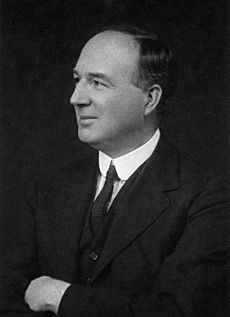Edward Mellanby facts for kids
Quick facts for kids
Edward Mellanby
|
|
|---|---|

Edward Mellanby in 1943
|
|
| Born | 8 April 1884 |
| Died | 30 January 1955 (aged 70) |
| Citizenship | British |
| Alma mater | Emmanuel College, Cambridge |
| Spouse(s) | May Tweedy (married 1914) |
| Awards |
|
| Scientific career | |
| Institutions | |
Sir Edward Mellanby (born April 8, 1884 – died January 30, 1955) was an important British scientist. He studied how living things work (a biochemist) and how food affects health (a nutritionist). He is famous for discovering vitamin D in 1919. He also showed how this vitamin helps stop a bone disease called rickets.
Contents
Early Life and Learning
Edward Mellanby was born in a place called West Hartlepool in England. His father owned a shipyard. Edward went to Barnard Castle School for his early education. Later, he studied at Emmanuel College, Cambridge, where he focused on physiology, which is the study of how the body works.
A Career in Science
After finishing his studies, Mellanby worked as a research student from 1905 to 1907. He then decided to study medicine. He became a medical doctor in 1913 after training at St. Thomas's Hospital in London.
Investigating Rickets
From 1913 to 1920, Mellanby taught at King's College for Women in London. During this time, he was asked to find out what caused rickets. Rickets is a disease that makes bones soft and weak.
Mellanby did some experiments with dogs. He fed them a diet of porridge. This diet made the dogs develop rickets. He then found that giving them cod liver oil could cure the disease. From this, he realized that rickets was caused by something missing in the diet.
Later, scientists discovered that the main cause of rickets is a lack of vitamin D. Our bodies usually make vitamin D when our skin gets sunlight. Eating foods rich in vitamin D, like cod liver oil, can also prevent or treat rickets.
Other Research and Roles
Edward Mellanby also studied how certain foods, especially cereals, could have bad effects if they contained a lot of phytic acid.
In 1914, he married May Tweedy. She was also a scientist who studied nutrition and dental disease.
In 1920, Mellanby became a professor at the University of Sheffield. He taught about pharmacology, which is the study of how medicines work. He also worked as a doctor at the Royal Infirmary in Sheffield.
From 1933 to 1949, he served as the secretary of the Medical Research Council. This is a very important group that helps organize medical research in the UK.
Awards and Honors
Mellanby received many awards for his important work:
- He became a Fellow of the Royal Society in 1925. This is a great honor for scientists.
- The Royal Society also gave him their Royal Medal in 1932.
- He received the Buchanan Medal in 1947.
- In 1932, he was given the Cameron Prize for Therapeutics of the University of Edinburgh.
He was also honored by the King. He was made a Knight Commander of the Order of the Bath (KCB) in 1937. In 1948, he became a Knight Grand Cross of the Order of the British Empire (GBE). He was even an Honorary Physician to the King in 1937.
Key Writings
Edward Mellanby wrote several books and papers about his research. One important book was Nutrition and Disease – the Interaction of Clinical and Experimental Work (1934). In this book, he wrote a lot about what happens when people don't get enough vitamins (called vitamin deficiency).
Here are some of his other important writings:
- Experimental Rickets (1925)
- The Fat-Soluble Vitamins (1933)
- A Story of Nutritional Research (1950)

